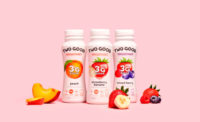High-protein foods figure prominently on IRI’s list of the most successful food and beverage launches of 2015. Alongside Oscar Mayer deli meat and Cheerios Protein, were Dannon Oikos Triple Zero yogurt, Yoplait Greek 100 Whips and fairlife milk.
The success of each is proof that marketers are on to something when they prioritize protein. Yet taking protein fortification from concept to commercialization can be challenging, even in protein-friendly dairy applications. There are a variety of dairy and plant-based proteins available.
In the International Food Information Council (IFIC) 2016 Food & Health Survey, 64% of respondents professed to making conscious efforts to consume protein.
That is “a higher percentage than for either fiber or whole grains,” said Jean Heggie, global product marketing leader for protein at DuPont Nutrition & Health, St. Louis, Mo.
“Protein powder is now being sought after by a broad range of consumers, from individuals aiming to maintain a healthy lifestyle to vegetarians seeking protein supplementation,” said Rikka Cornelia, product manager, BI Nutraceuticals, Long Beach, Calif.
“Consumers are becoming familiar with protein’s benefits,” said Vikki Nicholson, senior vice president, global marketing, for the U.S. Dairy Export Council, Arlington, Va. She said the nutrient’s effects are especially valuable to aging consumers, who want to maintain muscle mass, strength and functionality. But protein pays dividends at other life stages, too.
“As parents become educated on the benefits of protein, they’re realizing its importance in a child’s diet,” she said. “Research shows that one in three moms is trying to increase her child’s protein intake, helping to protect them from diseases later in life, build strong bones and teeth and aid in growth and physical activity.”
The vehicle by which many choose to drive greater protein intake is often a beverage, which has the advantages of being portable and easy to consume.
“Dairy-based beverages, especially smoothies, are the most popular candidates for protein fortification, since they have a thicker consistency ideal for protein powders,” Cornelia noted. “In addition, their on-the-go format, time of consumption — as breakfast or a snack — and established health halo contribute to their popularity.”
As formal mealtimes increasingly give way to continual snacking, formulators will have to figure out how to deliver protein in easy-eating, portable formats.
“Factor in replacement of dairy proteins with plant-based options for cost reduction and there’s no end in sight to protein projects,” said Kati Ledbetter, beverage applications manager at Archer Daniels Midland Co., Decatur, Ill.
All the right questions
Protein fortification may be a tricky business, but product developers who ask the right questions before they get started find not only that they face fewer hurdles as they proceed, but that they’re better prepared to clear the ones they face.
Ledbetter noted that consumer preferences and trends dictate many product qualities. Cornelia said that “extreme” athletes, for instance, will be more concerned with a product’s amino acid profile than vegetarians and vegans, who’ll want to know the protein’s source.
“Meanwhile, the general population will aim to maintain a healthy lifestyle with a product that has an enjoyable taste,” Cornelia said.
When David Sabbagh, DuPont’s senior group manager for innovation, works with customers, he wants to know about excluded ingredients, sensory and stability criteria, and whether or not a protein content claim is in the cards. Another consideration is the level of expertise the marketer has in formulating with protein. Marketers “need to ask if they have a trusted-partner supplier who can work with them to create the best product possible,” Sabbagh said.
“Certain minerals can negatively impact beverage stability because of interactions with proteins,” Sabbagh said. At lower pH levels, proteins are less soluble and more liable to precipitate, which poses challenges to stabilizing the proteins while also delivering a desirable flavor profile.
Blended families
Ledbetter is an advocate of blending multiple proteins to get to the right level, desired flavor and texture. For example, she suggests a blend of almond milk and peanut flour as a combination that can provide a protein content equivalent to what’s in a glass of milk while also appealing to consumers’ palates.
Sabbagh is a fan of blends, too. “Because different proteins have different sensory and functional attributes, blending “helps maximize the positive attributes while minimizing the negative,” he said. Dairy proteins’ “animal” or “barnyard” notes cancel out the “green” or “grassy” flavors characteristic of vegetable proteins, he said.
“Recent studies have shown that beverages with blended soy and dairy proteins have higher overall liking scores than comparable beverages with single protein sources,” Sabbagh said.
Smoothing the price spikes
Another advantage of protein blends: they smooth out price spikes, which is no small matter when dealing with an often costly ingredient like protein. Referring to IFIC’s 2016 Food & Health Survey, Heggie noted that 69% of respondents declared “that they were trying to consume more plant protein, in particular.”
Heggie called soy “the only commercially viable plant-protein source that can be considered a high-quality, nutritionally complete protein comparable in quality to dairy proteins.” Its sustainability story and small carbon footprint compared to animal-based proteins also work in its favor, she said.
But factors that she thinks really seal the deal for soy are its affordability, functionality and versatility. “Soy proteins are available in many different forms, including soy protein isolates, concentrates and flour, and in both powdered and textured formats,” she noted. For dairy use, she recommends soy protein isolate “because of its high-protein content — 90% — and its flavor and functional compatibility with dairy.”
DuPont developers fortified fluid-milk bases with soy protein combinations that deliver protein levels well beyond what occur naturally in milk. One such concept, Muscle Builder 25 (containing 25 grams of protein per serving), attracted notice at last year’s International Dairy Show for its protein profile.
Soy is hardly the only game in town when it comes to plant proteins, and among the alternatives is the humble lentil. Cecilia Wittbjer, marketing manager, Parabel, Melbourne, Fla., said that proteins extracted from the water lentil are compatible with dairy formulations, though processors still must mind inclusion levels.
“Since plant protein often imparts either a color, taste or both to the application,” she explained, “levels will have to be low unless the protein is extracted to a higher-protein density.”
Don’t forget dairy proteins
Of course, dairy processors could also enhance their products with dairy proteins.
“Both whey and milk proteins are high-quality, complete proteins that contain all the essential and nonessential amino acids the body needs,” Nicholson said, adding that whey proteins enjoy particular cachet thanks to their complement of leucine, “a branched-chain amino acid accountable for muscle synthesis.”
Dairy proteins also supply functional properties that processors appreciate. Whey proteins improve texture, flavor and color and help emulsify, stabilize and enhance flow properties and dispersion in dry mixes, Nicholson said. They form gels at a protein level of about 7% at neutral pH, and remain soluble over an even wide range of pH and are fairly heat stable, denaturing mainly at 145°F and above.
As for caseins, they’re “generally good at fat emulsification, foaming and binding water, and have good heat stability as long as pH is above 6,” Nicholson continued. Micellar casein concentrates, or MCC, offer another high-quality protein option. Derived from an ultrafiltration process that leaves the casein in its native micellar form, they’re nutritionally and functionally similar to caseins while also delivering calcium and phosphorous at ratios like those found in milk.
If a beverage is being formulated in an acid range of 3.0 to 4.5 where hot-fill processes are typical, whey protein is the best choice because milk protein will likely have poor solubility and will precipitate,” Nicholson said.
In the case of a dairy shake that lies nearer to neutral (a pH of 6.5 to 7.0), milk protein’s heat stability will stand up best to ultra-high-temperature processing,” Nicholson said.
The bottom line is still taste, regardless of the protein source that dairy processors use.
“Price, packaging and marketing” — even protein level —“are irrelevant if the product isn’t enjoyable to consumers,” Cornelia said. “It may attract the first-time buyer, but it won’t keep them. Ultimately, taste attracts the repeat buyer.”



